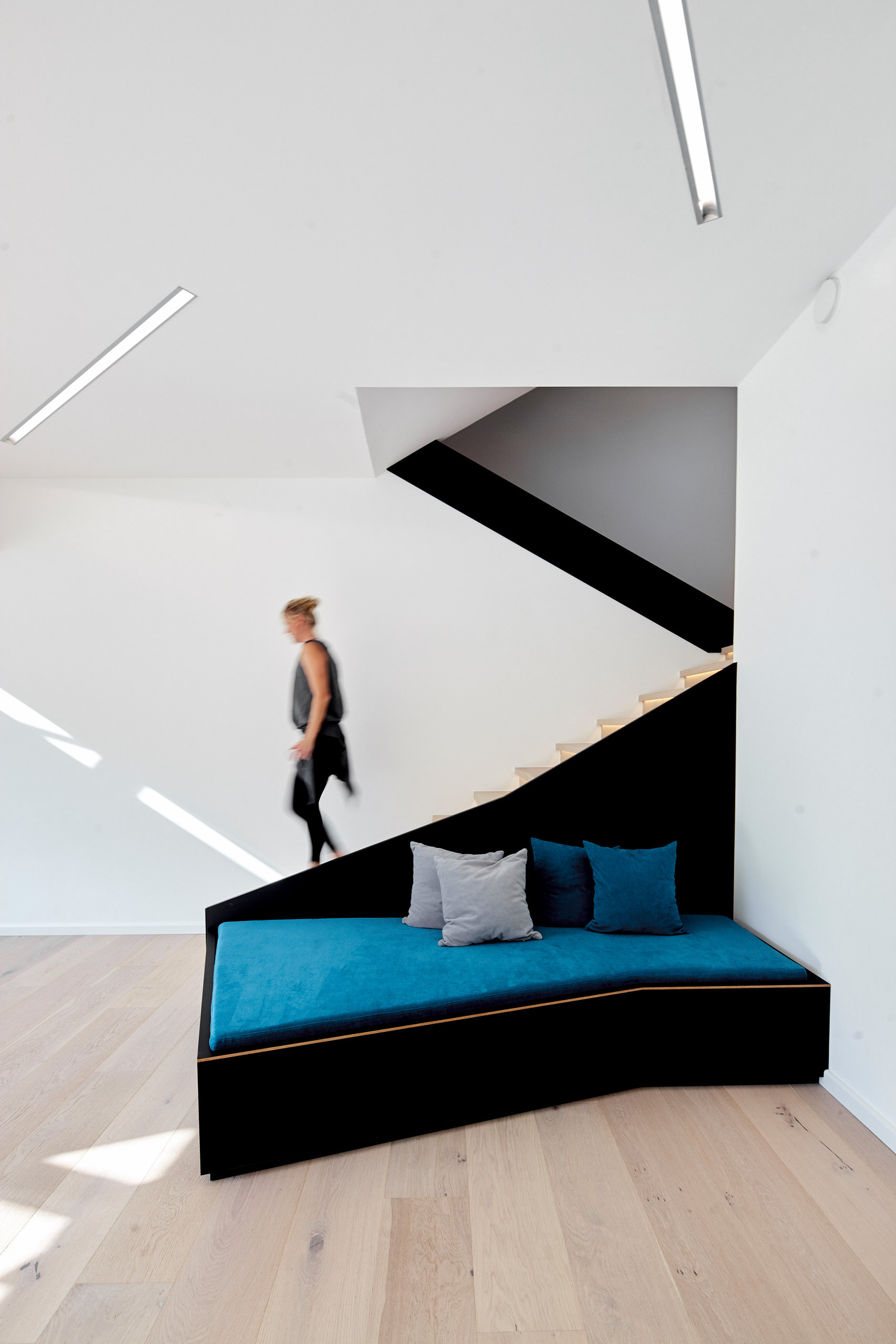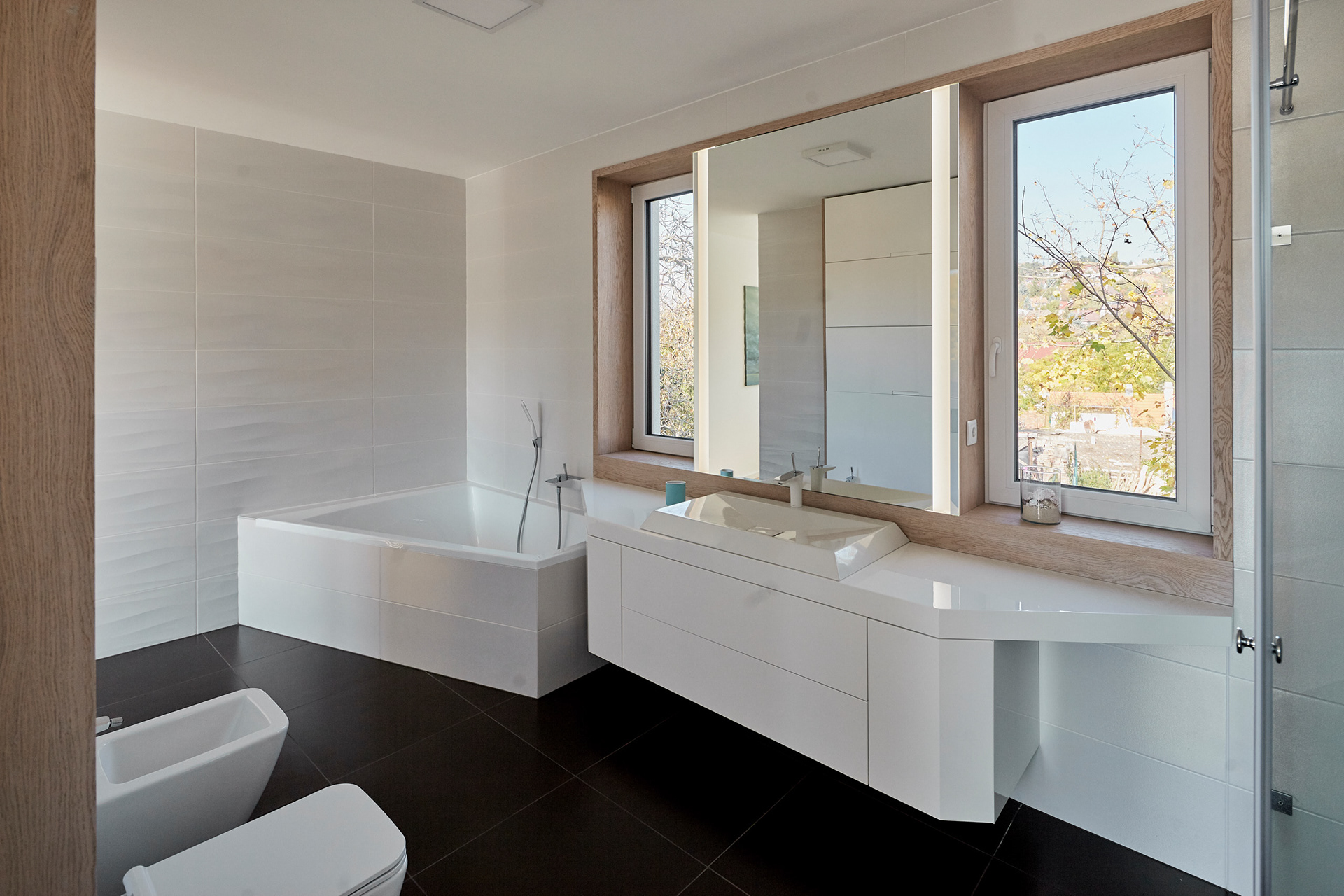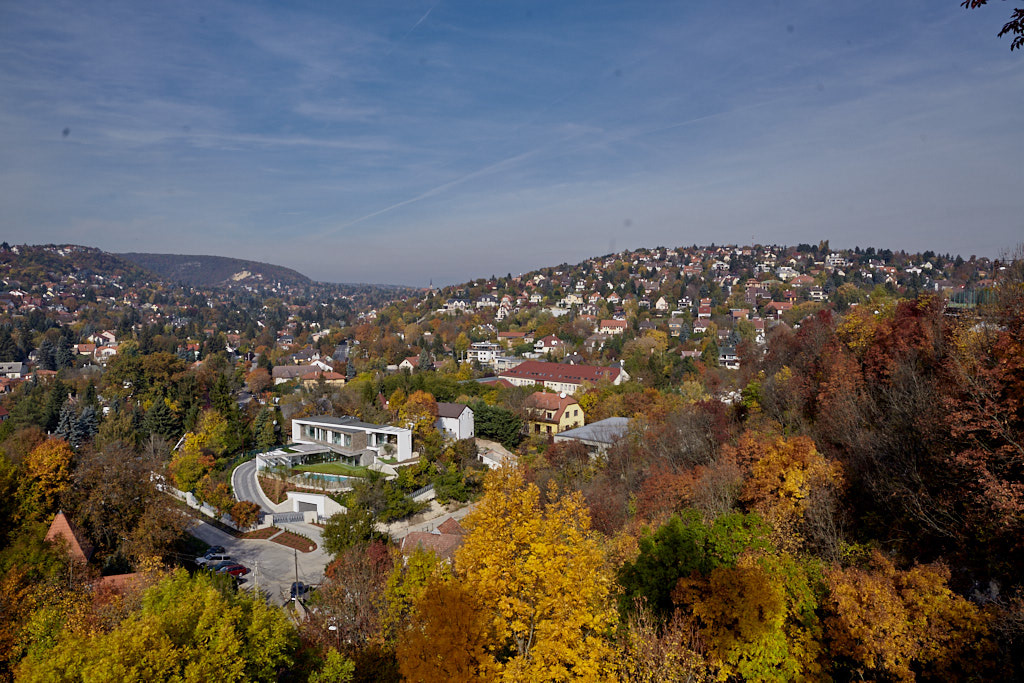


































Tectonic Force Lines - Villa on the border of the city
Tektonikus Erővonalak - Villa Hűvösvölgy határán
Tektonikus Erővonalak - Villa Hűvösvölgy határán
A single movement. I find it always has an impact on the ones interested in architecture if a house shows dynamism not by only by it’s immanent formality and externalities but from layer to layer, tectonically, showing the mass relations of various stratifications, it is able to "move" in bulk. The most important virtue of this house designed by Koppány Bánfalvi, is this gesture, which I call tectonic, pervading the whole design language of the house.
Those who had been at the border of Hűvösvölgy and Hidegkút were sure to notice that certain formations of the terrain seemed to be out of their place. From architects I know that once there was a quarry in this area, and even today it can be noticed as small rocky cleavages between the hills and "piles” dumped that are results of mining. In fact, almost exclusively the road system shows it most spectacularly that human hands had once formed this landscape. The owner of the villa, who purchased this plot on a high ground in 2015 worked with Bánfalvi multiple times previously. Of course, before construction, this was a bushy, greenwood area, whose real values were revealed during the construction, more precisely during the installation of the new house. We are talking about a protrusion of which parallel to its contour lines the main mass of the house could be constructed. As a consequence, a flat plateau, an internal garden was formed between the long, bricky form and the steep chamfer of the terrain. The basic concept of the two-story building reacts to this garden, which not only opens up with a long glass surface to this free space, but acts more than that. This “act” is not just visible on the floor plan but can also be identified from a bird's eye view from the neighboring hilltop. It is a gesture of how from under a white roofing - as a sort of shell, box or frame, - another grey cladded building mass turns out towards the garden. The closed prism opens up like a pocket knife or a folding fan, which has it’s pivot point above the garage. This small movement reveals a kind of a frame who’s "turning” edges, and a longitudinally extending pierced roof form a special connection between the exterior and interior spaces of the house. Just a tiny move, but extraordinary energies are released, dynamising the whole composition. These are open-closed spaces created by the movement of the contour of the house. It is not merely the roof-like and pierced projection of the longer mass, but also the plane of the ground-floor kitchen that stretches out to the terrace to form a restrained, fragmented wall. These opening masses also allowed a swimming pool to be placed in the protected garden area. Its trapezoidal shape also rhyme with the broken, wedge-like fine lines of the house. Masses slide out of one another, framing planes create open-closed spaces with unparalleled consistency.
It is good to see that this tectonic system can be identified in the inside of the building as well, in the interior design elements, the built-in furniture. Thus, in these “glass-membrained” interiors opening up to the garden, a black-blue furniture system of the dining- and the living room takes the interpretation realized in the architectural program and the structure of the house a step further: its edges, bulges and curls do not merely radiate thoughtful planning and design but also serve as functional architectural elements. We are dealing with a smart and exciting building from a meaningful architectural program that can handle its masses very well and can solve the challenges of the terrain
Egyetlen mozdulat. Mindig hatással van az építészet iránt érdeklődőre, ha egy ház nem formáltságának immanens módján, szoborszerűségében vagy külső felszínén mutat dinamikát, hanem rétegről rétegre, tektonikusan, a különféle rétegződések tömegviszonyait láttatva, tömbszerűen képes „megmozdulni". E Bánfalvi Koppány tervezte háznak legfontosabb erénye az, hogy ez az általam tektonikusnak mondott mozdulat a ház egész formanyelvét áthatja.
Akik jártak már Hűvösvölgy és Hidegkút határán, azok biztosan felfigyeltek arra, hogy bizonyos domborzati formák mintha nem volnának a helyükön. Az építészektől tudom, hogy ezen a környéken egykoron kőbánya működhetett, és ez kisebb sziklás lehasadásokként azonosítható ma is a dombok között, illetve a bányászat nyomán imitt-amott meddőhányóként feltöltött “kupacok” is láthatóak. Igazából szinte csak az utcarendszer mutatja látványosabban, hogy egykor emberi kéz formálta ezt a vidéket. Egy ilyen feltöltésen, magaslaton vásárolt telket a villa építettője, aki 2015-ben nem először dolgozott Bánfalviékkal. Természeten az építés előtt ez egy bokrokkal benőtt, csalitos terület volt, aminek igazi értékeit pont az építkezés, pontosabban az új ház telepítése tárta fel. Egy kiemelkedésről van tehát szó, aminek szintvonalaival párhuzamosan épülhetett meg a ház fő tömege, és következményeként a hosszú, téglány alapforma és a meredekebb letörés között egy sík plató, tulajdonkeppen belső kert szerkesztődött ki. Erre a kertre, szabad területre reagál a kétszintes épület alapkoncepciója, ami nem pusztán hosszú üvegfelületeket nyit erre a szabad térre, de többet is tesz ennél. Ez a „tett" nem pusztán az alaprajzról, hanem a szomszéd dombtetőről készített madártávlati fotóról is jól azonosítható. Arról a mozdulatról van szó, hogyan a fehér tetőlemez - mint egyfajta héjazat, keret, doboz - alól a kert felé kifordul az emeleti, szürkés külső burkolattal fedett épülettömeg. Kinyíló bicska- vagy legyezőmódra rendeződik át a zárt hasáb, aminek a forgáspontja az alagsorba épített garázs felé került. Ennek az apró mozdulatnak a hatására feltárul egyfajta keret, aminek élei, “lefordulásai", illetve a hosszan kinyúló, áttört tetőrész különleges kapcsolatot teremt a ház külső teresedései és belső terei között. Apró mozdulat, de rendkívüli energiák szabadulnak fel, dinamizálják az egész kompozíciót. Nyitott-zárt terek ezek, amik a ház kontúrjának átmozgatásából jöttek létre. Nem pusztán a hosszabb tömeg tető jellegű és áttört kinyúlása ilyen térrész, hanem a földszinti konyha terasza felé is kifeszül egy sík, ami visszafogott, tört térfalat is alkot. Ezek az elnyíló tömegek lehetőséget adtak arra is, hogy egy kerti medence kerüljön a védett kertrészbe, aminek trapézszerű formája ugyancsak rímel a ház tört, ékes vonalaira. Tömegek csúsznak ki egymásból, keretező síkok alakítanak nyitott-zárt teret hallatlan következetességgel.
Jó látni, hogy ez a tektonikus rendszer az épület belső tereiben, a belsőépítészeti elemekben, beépített bútorokban is azonosítható. Így a kert felé „üvegmembránnal" nyíló belső terekben, az étkezőben, nappaliban látható fekete-kék bútorrendszer érzésem szerint tovább értelmezi a ház szerkezetével megvalósított építészeti programot. Élei, tömbösödései, kiharapásai nem pusztán funkcionális átgondoltságot sugároznak, hanem önálló építészeti elemmé válnak. Okos, izgalmasan formált, értelmes építészeti programot megvalósító házzal van tehát dolgunk, ami jól kezeli tömegeit, képes oldani a terep adottságaiból adódó kihívásokat
Featured in | Rólunk írtak:
architecture | építész:
Koppány Bánfalvi, Ditta Dobos (BM Építész Kft.)
Koppány Bánfalvi, Ditta Dobos (BM Építész Kft.)
interior design | belsőépítész:
Marcell Benson
Marcell Benson
doors & windows | nyílászárók:
Doorland Kft.
Doorland Kft.
photos | fotó:
Zsolt Batár
Zsolt Batár
text | szöveg:
OCTOGON (2018/1-16) / József Martinkó
OCTOGON (2018/1-16) / József Martinkó
translation & publication | fordítás & publikáció:
Attila Pataki
Attila Pataki
